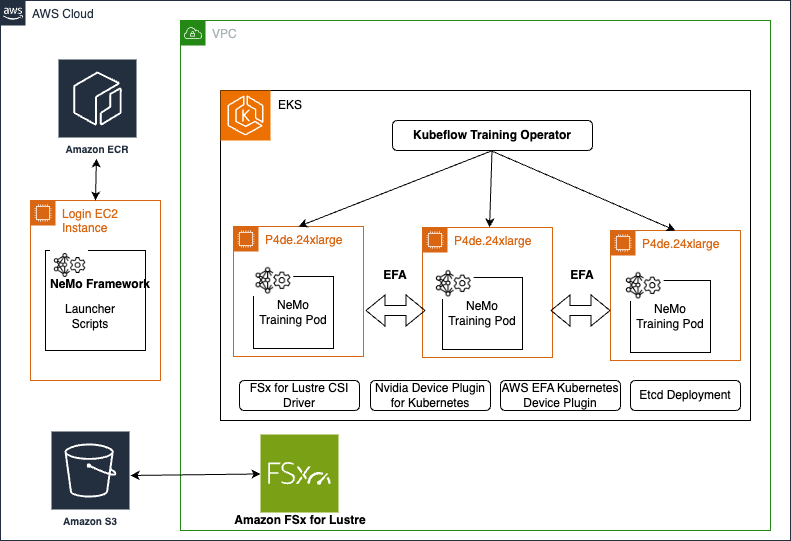AWS Machine Learning Blog
Derive meaningful and actionable operational insights from AWS Using Amazon Q Business
As a customer, you rely on Amazon Web Services (AWS) expertise to be available and understand your specific environment and operations. Today, you might implement manual processes to summarize lessons learned, obtain recommendations, or expedite the resolution of an incident. This can be time consuming, inconsistent, and not readily accessible. This post shows how to […]
Accelerate your generative AI distributed training workloads with the NVIDIA NeMo Framework on Amazon EKS
In today’s rapidly evolving landscape of artificial intelligence (AI), training large language models (LLMs) poses significant challenges. These models often require enormous computational resources and sophisticated infrastructure to handle the vast amounts of data and complex algorithms involved. Without a structured framework, the process can become prohibitively time-consuming, costly, and complex. Enterprises struggle with managing […]
Governing the ML lifecycle at scale, Part 2: Multi-account foundations
Your multi-account strategy is the core of your foundational environment on AWS. Design decisions around your multi-account environment are critical for operating securely at scale. Grouping your workloads strategically into multiple AWS accounts enables you to apply different controls across workloads, track cost and usage, reduce the impact of account limits, and mitigate the complexity […]
Video auto-dubbing using Amazon Translate, Amazon Bedrock, and Amazon Polly
This post is co-written with MagellanTV and Mission Cloud. Video dubbing, or content localization, is the process of replacing the original spoken language in a video with another language while synchronizing audio and video. Video dubbing has emerged as a key tool in breaking down linguistic barriers, enhancing viewer engagement, and expanding market reach. However, […]
How Mixbook used generative AI to offer personalized photo book experiences
Years ago, Mixbook undertook a strategic initiative to transition their operational workloads to Amazon Web Services (AWS), a move that has continually yielded significant advantages. This pivotal decision has been instrumental in propelling them towards fulfilling their mission, ensuring their system operations are characterized by reliability, superior performance, and operational efficiency. In this post we show you how Mixbook used generative artificial intelligence (AI) capabilities in AWS to personalize their photo book experiences—a step towards their mission.
Using Amazon Bedrock Agents to interactively generate infrastructure as code
In this blog post, we explore how Agents for Amazon Bedrock can be used to generate customized, organization standards-compliant IaC scripts directly from uploaded architecture diagrams. This will help accelerate deployments, reduce errors, and ensure adherence to security guidelines.
Improve RAG accuracy with fine-tuned embedding models on Amazon SageMaker
This post demonstrates how to use Amazon SageMaker to fine tune a Sentence Transformer embedding model and deploy it with an Amazon SageMaker Endpoint. The code from this post and more examples are available in the GitHub repo.
How BRIA AI used distributed training in Amazon SageMaker to train latent diffusion foundation models for commercial use
This post is co-written with Bar Fingerman from BRIA AI. This post explains how BRIA AI trained BRIA AI 2.0, a high-resolution (1024×1024) text-to-image diffusion model, on a dataset comprising petabytes of licensed images quickly and economically. Amazon SageMaker training jobs and Amazon SageMaker distributed training libraries took on the undifferentiated heavy lifting associated with infrastructure […]
Create custom images for geospatial analysis with Amazon SageMaker Distribution in Amazon SageMaker Studio
This post shows you how to extend Amazon SageMaker Distribution with additional dependencies to create a custom container image tailored for geospatial analysis. Although the example in this post focuses on geospatial data science, the methodology presented can be applied to any kind of custom image based on SageMaker Distribution.
Automating model customization in Amazon Bedrock with AWS Step Functions workflow
Large language models have become indispensable in generating intelligent and nuanced responses across a wide variety of business use cases. However, enterprises often have unique data and use cases that require customizing large language models beyond their out-of-the-box capabilities. Amazon Bedrock is a fully managed service that offers a choice of high-performing foundation models (FMs) […]









